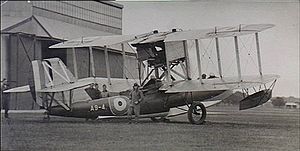Supermarine Seagull Video - Hendon Aircraft Museum
|
|
Supermarine Seagull

Picture - Australian Seagull III at RAAF Base Richmond circa. 1928
Role: Reconnaissance flying boat
Manufacturer: Supermarine
First flight: May 1921
Primary users: Fleet Air Arm
Royal Australian Air Force
Produced: 1922-1933
Number built: 34
Developed from: Supermarine Seal
The Supermarine Seagull was a British amphibian biplane flying boat developed from the Supermarine Seal by the Supermarine company. The Seagull was constructed of wood. The lower wing was set in the shoulder position and had two bays. The engine was mounted in a nacelle slung from the upper wing and powered a four-blade propeller in tractor configuration. The fuselage had an oval cross-section and had a planing bottom with two steps.
Design and development
The prototype, which became known as the Seagull Mk I, was modified from an existing Supermarine Seal II in 1921. Only one aircraft was made. A Napier Lion II engine was fitted and there were modifications made to the nacelle.
Produced from 1922, the production aircraft, the Seagull Mk II, had a Napier Lion III engine, and these were supplied to the Air Ministry and Royal Navy. A total of 25 were built, although some of these were later modified.
The Seagull Mk III was the Australian version, built in 1925. These were similar to the Seagull II but with a Napier Lion V engine and radiators modified for tropical use. Six of these were supplied to the Royal Australian Air Force, and one other Seagull III was built for Japan.
One Seagull II was rebuilt and fitted with Handley-Page leading edge slots and twin fin and rudders in 1928. This was considered to be the Mark IV, although Supermarine never designated it as such. Three ex-service aircraft were later placed on the British Civil Register.
One additional aircraft was built in 1933, using a Bristol Jupiter IX engine in the pusher configuration. This became known as the Seagull V and was the forerunner of the Supermarine Walrus.
Operational history
The type was used operationally as a fleet spotter. The Seagull II was the first British aircraft to be catapult launched in 1925. The crew was normally three (Pilot, Observer, and Radio-Operator). The sole armament was a .303 in (7.7 mm) Lewis gun.
Operators
Australia
Royal Australian Air Force received 9 aircraft.
No. 101 Flight RAAF
Japan
Imperial Japanese Navy Air Service received 1 aircraft.
United Kingdom
Fleet Air Arm received 26 aircraft.
Surviving aircraft
The Fleet Air Arm Museum owns the front hull of an unknown Seagull. It was in use until 1974 as a garden shed, and presented to the museum in exchange for a new shed. It is currently on long-term loan to Solent Sky, an air museum in Southampton.
Specifications (Seagull I)
Data from Supermarine Aircraft since 1914
General characteristics
Crew: Three (pilot, wireless operator & observer)
Length: 34 ft 6 in (10.51 m)
Wingspan: 45 ft 11 in (13.99 m)
Height: 13 ft 6 in (4.11 m)
Wing area: 605 ft² (56.2 m²)
Empty weight: 3,691 lb (1,674 kg)
Loaded weight: 5,462 lb (2,477 kg)
Powerplant: 1x— Napier Lion II 12-cylinder water-cooled W-block piston engine, 480 hp (358 kW)
Performance
Maximum speed: 80 mph at sea level (70 knots, 129 km/h)
Service ceiling: 9,000 ft (2,743 m)
Endurance: 3½ hours
climb to 3,000 ft (915 m): 6.8 min
Armament
1 x— .303 in (7.7 mm) Lewis gun
Specifications (Seagull II)
Data from
General characteristics
Crew: Three (pilot, wireless operator and gunner)
Length: 37 ft 9 in (11.5 m)
Wingspan: 46 ft (14.02 m)
Height: 14 ft (4.26 m)
Wing area: 593 ft² (55.11 m²)
Empty weight: 3,820 lb (1,736 kg)
Loaded weight: 5,691 lb (2, 586 kg)
Powerplant: 1x— Napier Lion III 12-cylinder water-cooled W-block piston engine, 492 hp (367 kW)
Performance
Maximum speed: 85 mph at sea level (138 km/h)
Service ceiling: 9,150 ft (2,790 m)
Endurance: 4½ hours
Armament
1 x— .303 in (7.7 mm) Lewis gun
Related development
Supermarine Walrus
Bibliography
Andrews, C.F. and Morgan, E.B. Supermarine Aircraft Since 1914. London: Putnam Books Ltd., 2nd revised edition 2003. ISBN 0-851-77800-3.
Brown, David. "Supermarine Walrus I & Seagull V Variants". Aircraft in Profile, Volume 11. Windsor, Berkshire, UK: Profile Publications Ltd., 1972.
Kightly, James and Wallsgrove, Roger. Supermarine Walrus & Stranraer. Sandomierz, Poland/Redbourn, UK: Mushroom Model Publications, 2004. ISBN 83-917178-9-5.
Living Warbirds: The best warbirds DVD series.
Source: WikiPedia